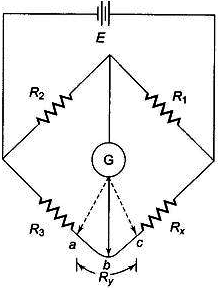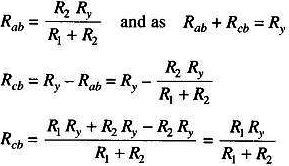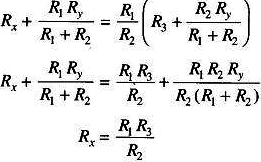In this article, you will find the study notes n Measurement of Low, Medium & High Resistances which will cover the topics such as Classification of Resistance, to Measure Low Resistances are Kelvin Bridge Method, Kelvin-Double Bridge Method, to Measure Medium Resistances such as Ammeter-Volt Meter Method, Ohmmeter Method, Wheat Stone Bridge Method, to measure high resistances Direct Deflection method, Loss of Charge method & Megha ohm bridge method.
Classification of Resistance
- Low Resistance is the range of '0.1Ω to 1Ω'.
- Medium Resistance is the range of 1Ω to few Megha ohm.
- High resistance is .1MΩ to the higher range.
Methods For Measurement of Low Resistances
- Kelvin Bridge Method
- Kelvin Double Bridge
- Ammeter – voltmeter method
Methods For Measurement of Medium Resistances
- Ammeter–Voltmeter method
- Wheat stone bridge method
- Ohmmeter method
Methods For Measurement of High Resistances
- Direct Deflection methods
- Loss of Charge methods
- Megha ohm bridge methods
Measurement of Low Resistances
When the resistance to be measured is of the order of magnitude of bridge contact and lead resistance, a modified form of Wheatstone’s bridge, the Kelvins Bridge theory is employed.
Kelvin Bridge Method
Kelvins Bridge theory is a modification of Wheatstone’s bridge and is used to measure values of resistance below 1 Ω. In low resistance measurement, the resistance of the leads connecting the unknown resistance to the terminal of the bridge circuit may affect the measurement.

 and the usual balance equations for the bridge give the relationship
and the usual balance equations for the bridge give the relationship

 Kelvin Double Bridge Method:
Kelvin Double Bridge Method:
- Kelvin’s Double bridge is a modification of Kelvins Bridge theory’s bridge and always used in the measurement of low resistance.
- It uses two sets of ratio arms and the four terminal resistances for the low resistance consider the ckt.
- The first set of ratio P and Q.
- The second set of ratio arms are p and q is used to connected to the galvanometer to a pt d.
- At an Approx. potential between points m and n to eliminate the effects of connecting lead of resistance r between the known std. resistance ‘s’ and unknown resistance R.
- The ratio P/Q is made equal to p/q. under balanced condition there is no current flowing through galvanometer which means voltage drop between a and b, Eab equal to the
voltage drop between a and c, Eamd.
I1P=I2 R
I1=I3=E/P+Q
I2=I4=E/R+S
E=emf of the battery
If three of the resistances are known then fourth may be determined by formula…
R=S*P/Q
Where R is the unknown resistance, S is called the standard arm resistor and P and Q are called the ratio arms.
Methods For Measurement of Medium Resistances
- Ammeter–Voltmeter method
- Wheat stone bridge method
- Ohmmeter method
Ammeter-Volt Meter Methods
- We measured the current and the voltage across a variable resistance using the voltmeter-ammeter method, in this method we used two galvanometers with specified range discussed, later on, three-decade boxed the first one is used as the variable resistance Rx, the second and the third are the shunt and series resistances for the ammeter and the voltmeter.
- We must know how to convert the galvanometer into a voltmeter or an ammeter. To convert a PMMC into a voltmeter we connect a series resistance with it, the value of this resistance changes according to the value of Rx.
There are two possible connections for the measurement of Medium Resistance using Ammeter Voltmeter Method as shown in the figure below: In both the cases, the reading of Voltmeter and Ammeter is taken.
If the Voltmeter reading is V and Ammeter reading is I then the measured Resistance will be
Rm = V/I
- This measured Resistance Rm will be the true value of the Resistance if and only if the Resistance of Ammeter is zero and that of Voltmeter is infinite.
- But actually, this is not possible to achieve zero resistance Ammeter and infinite Resistance Voltmeter. Therefore the measured value of resistance Rm will deviate from the true value R (Say).
Case 1:
The voltmeter is measuring the Voltage drop across the Ammeter as well as the resistor.
It is clear from the figure (1) that Voltmeter is measuring the Voltage drop across the Ammeter as well as the resistor.
So V = Va + Vr
Let current measured by Ammeter = I
Therefore, measured Resistance Rm = V/I
So, Rm = (Va+Vr) / I =(IRa+IR) / I = Ra+R
Therefore, the measured Resistance is the sum of Resistance of Ammeter and true Resistance. Therefore measured value will only represent true value if Ammeter Resistance Ra is Zero.
True value of Resistance R = Rm–Ra= Rm(1-Ra/Rm)
Relative Error = (Rm-R)/R = Ra/R
Note: Relative Error will be less if the true value of Resistance to be measured is high as compared to the internal Resistance of Ammeter.
Case 2:
The voltmeter is connected in which Voltmeter is connected toward Resistance R whose value is to be measured, Here Ammeter will read the current flowing through the Voltmeter and Resistance R.
Therefore current measured by Ammeter Ia = Iv+Ir
So, Ia = Iv+Ir
Measured Resistance
Rm = V/Ia = V/(V/Rv+V/R) = RvR/(R+Rv) = R/(1+R/Rv)
Therefore, true value of Resistance R = RmRv/(Rv-Rm)
= Rm(1-Rm/Rv)
Therefore, the true value of Resistance will only be equal to measured value if the value of Voltmeter Resistance Rv is infinite.
If we assume that the value of Voltmeter Resistance Rv is large as compared to the Resistance to be measured R, then Rv>>>Rm
So, True value R = Rm(1+Rm/Rv)
Thus from the above equation, it is clear that the measured value of Resistance is smaller than the true value.
Relative Error = (Rm-R)/R
= -R/Rv
Therefore, it is clear from the expression of Relative Error that, error in measurement will be low if the value of Resistance under measurement is very less as compared to the internal Resistance of Voltmeter.
Wheat Stone Bridge Method
- The Wheatstone bridge is a circuit used to compare an unknown resistance with a known resistance.
- The bridge is commonly used in control circuits. For instance, a temperature sensor in an oven often consists of a resistor with a resistance that increases with temperature.
- This temperature-dependent resistor is compared with a control resistor (outside the oven) to control a heater and maintain a set temperature.
Since VAB = 0, the voltage drop from C to A must equal the voltage drop from C to B, VCA = VCB. Likewise, we must have VAD = VBD. So we can write,
Thus, the unknown resistance Rx can be computed from the known resistance Rk and the known ratio.Notice that the computed Rx does not depend on the voltage Vo; hence, Vo does not have to be very stable or well-known.Another advantage of the Wheatstone bridge is that, because it uses a null measurement, (VAB = 0), the galvanometer does not have to be calibrated.
Temperature dependence of resistivity
For this part, the unknown Rx is a copper wire coilAs a measure of how sensitive the resistivity is to temperature changes, we can compute the fractional change in the resistivity divided by the change in temperature
 Ohmmeter Method
Ohmmeter Method
- The ohmmeter is an electronic instrument which is widely used to check a complete circuit or to measure the resistance of a circuit element.
- Micro-Ohmmeter, Mega Ohmmeter, and Milli- Ohmmeters are used to measure resistance in different applications of electrical testing.
Series Ohm-Meter
In a series type Ohmmeter, the R1 is the current limiting resistor, the Rx is the unknown resistor, the R2 is the zero adjust resistor, the Rm is the internal resistance, E is the internal battery voltage, and A and B are the output terminals of the Ohmmeter.
In a series type Ohmmeter, the R1 is the current limiting resistor, the Rx is the unknown resistor, the R2 is the zero adjust resistor, the Rm is the internal resistance, E is the internal battery voltage, and A and B are the output terminals of the Ohmmeter.
Shunt Type Ohmmeter
Shunt type Ohmmeter is used to measure small values of resistance.In this type of Ohmmeter, the movement mechanism is connected parallel to the unknown resistance Rx.When the A and B terminals are closed, then the unknown resistor Rx is short-circuited, the needle reads zero because full current flows through the resistor Rx, and I=0 through the meter. Therefore, zero current reading is marked as 0 Ohms.
When the A and B terminals are opened, then the unknown resistor Rx is open circuited, no current flows through the Rx and full-scale current flows through the meter as the resistor R1 is adjusted. So, maximum current reading is marked ∞ Ohms.
Methods For Measurement of High Resistances
- Direct Deflection methods
- Loss of Charge methods
- Megha ohm bridge methods
Megohm Bridge Method
- We have seen many methods to find low and medium resistances here we discuss methods for high resistance measurement.So now I will explain Megohm bridge method.
- In the given figure below it shows a very high resistance R with its two main terminals A and B, and a guard terminal, which is put on the insulation.
- This high resistance R is between main terminals A and B and the leakage resistances RAG and RBG between the main terminals A and B of from a "Three-terminal resistance".
- The operation of a Mega ohm bridge can be explianed as it is a self-contained Mega ohm bridge which includes power supplies, bridge a member, amplifiers, and indicating instrument.
- It has a range from 0.1 MΩ to 10⁶ MΩ. The accuracy is within 3% for the lower part of the range to possible 10% above 10,000 MΩ.
Loss of Charge Method
- In the circuit C is a capacitor of known capacitance, V is electrostatic volt-meter, R1 is the total leakage resistance of the capacitor and volt-meter and R is the resistance to be measured.
- In this method, the capacitor is first charged by means of a battery to some suitable voltage by putting switch S on stud 1 and then allowed to discharge through the resistances R and R1 by throwing switch S to stud 2.
- The time taken t for the potential difference to fall from V1 to V2 during discharge is observed by a stopwatch. The equivalent resistance of R1 and R is given as
R’ = t/(C loge V1/V2 )
- From the above expression the value of R’ can be determined. The test is then repeated with unknown resistance R disconnected, the capacitor being discharged through R1 can also be determined. Knowing the value of R’ and R1 the value of unknown resistance can be determined from the relation
1/R = 1/R-1/R1
- While measuring insulation resistance of a cable or a capacitor the test need not be repeated. In this case, C will be the capacitance of the cable (or capacitor) under test, which must be known (may be determined by any method if not known) and R1 will be the insulation resistance to be measured. NO external resistance is to be inserted in the circuit. The value of R1 then can be obtained directly from the expression.
R = t/(C log V2/V1
This method of measurement is associated with serious difficulties and error such as
- Leakage and absorption effects
- Effect of time electrification and
- Effect of temperature upon insulation resistance.
Direct Deflection Method
- The figure shows the measurement of high resistance using direct deflection method.
- For measurement of high resistance such as insulation resistance of cables, a sensitive galvanometer of d’Arsonval type is used in place of the microammeter.
- In fact, many sensitive type of galvanometers can detect currents from 0.1-1nA.therefore, with an applied voltage of 1kV, resistance as high as 1012 to 10*1012O can be measured.
- The first figure shows the direct deflection method for measurement of high resistance having the metallic sheath.
- The galvanometer G shows the current between the conductor and the metallic sheath.
- The leakage current is carried by the guard wire wound on the insulation and therefore does not flow through the galvanometer.

Comments
Post a Comment
Thanks for reading my Blogs or articles